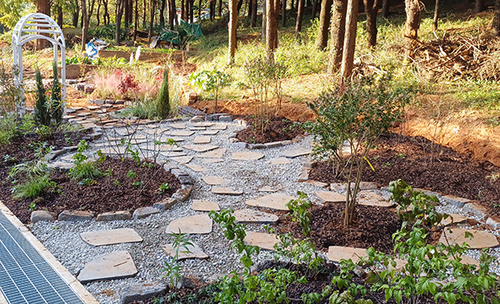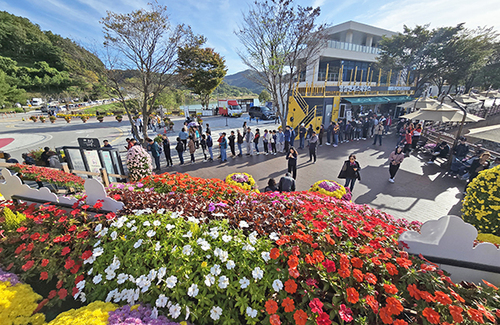| ▲ 연면적 154.9㎡ 규모의 2층 건물로 1층은 정면 3칸ㆍ측면 4칸이며 2층은 정면 3칸ㆍ측면 2칸으로 이익공(二翼工) 팔작지붕을 얹은 '무주 한풍루(寒風樓)' 국가지정문화재 보물 승격 1주년 기념공연 및 행사가 오는 24일 개최된다. (한풍루 전경) / 사진제공 = 무주군청 © 김현종 기자 |
|
연면적 154.9㎡ 규모의 2층 건물로 1층은 정면 3칸ㆍ측면 4칸이며 2층은 정면 3칸ㆍ측면 2칸으로 이익공(二翼工) 팔작지붕을 얹은 '무주 한풍루(寒風樓)' 국가지정문화재 보물 승격 1주년 기념공연 및 행사가 오는 24일 개최된다.
전북 무주군은 "1973년부터 전라북도 유형문화재 제19호로 보호를 받아오다 지난해 6월 국가지정문화재 '보물'로 승격된 의미를 되새기는 동시에 지역 문화의 우수성을 널리 알려 군민의 자긍심을 높이는 차원으로 기념 공연을 마련했다"고 17일 밝혔다.
특히 무주농악보존회가 이끄는 길놀이(무주군청~한풍루)을 시작으로 춤꽃 무용단의 식전공연에 이어 기념식ㆍ6개 읍면 결선을 통해 선발된 노래꾼들이 실력을 뽐낸다.
또 국악인 지유진ㆍ색소폰 연주자 신유식ㆍ가수 진성 등이 초청 무대에 올라 '무주 한풍루 국가지정문화재 보물 승격 1주년'을 축하 공연도 예정돼 있다.
황인홍 무주군수는 "군민의 힘으로 한풍루를 옮겨 세운 지 50년 만에 보물로 승격된 감격이 자손대대 자랑으로 남을 수 있도록 보존 및 관리에 최선을 다하겠다"며 "한풍루가 보물이라는 것을 다시 한 번 상기시키며 역사와 문화예술 자원의 소중함을 다시 한 번 새긴다는 의미를 담아 행사를 개최하게 됐다"고 말했다.
한편 '무주 한풍루(寒風樓)' 누각의 건립연대는 확실하지 않지만 세조 11년(1465년) 전라 관찰사를 역임한 성임이 한풍루를 다녀간 뒤 남긴 시가 있는 것으로 보아 적어도 이전에 건립된 것임을 알 수 있다.
1592년 임진왜란 당시 왜군의 방화로 소실됐으나 임진왜란이 끝난 1599년 복설돼 1783년까지 보수 및 중수과정을 거쳐 1910년 이후 불교 포교당과 무주 보통학교 공작실로 활용되기도 했다.
또 1936년 영동과 옥천 남쪽의 하천이 양강(楊江)을 이룬 호수 위에 있던 환선루(喚仙樓)가 큰물에 허물어지자 이 고장 선비 37명이 1938년 무주에 있던 한풍루(寒風樓)를 영동 양산면 가곡리 금강변 옛터 옆으로 옮기는 세우는 수난을 겪기도 했다.
하지만, 1971년 무주 한풍루 복구추진위원회 요구에 따라 '한풍루'가 무주읍 지남공원 내 현 위치로 누정 건축물의 역사성ㆍ건축성ㆍ학술성 가치를 높일 수 있도록 원부재를 최대한 활용, 이건(移建)했다.
문화재청은 ▲ 오랜 역사성(조선 초 건립) ▲ 우리나라에 몇 안 되는 ‘관아누정’이라는 희소성 ▲ 목재의 조각수법과 입면의 비례 등 건축요소에서 확인되는 예술성과 특이성 등의 충분한 가치를 평가해 국가지정문화재 '보물'로 지정했다.
'무주 한풍루(寒風樓)'는 ▲ 남원 = 광한루(廣寒樓) ▲ 전주 = 한벽당(寒碧堂)과 함께 호남삼한(三寒)으로 꼽힌다.
☞ 아래는 위 기사를 구글 번역이 번역한 영문 기사의 '전문' 입니다.
구글 번역은 이해도를 높이기 위해 노력하고 있으며 영문 번역에 오류가 있음을 전제로 합니다.
【Below is the 'full text' of the English article translated by Google Translate.
Google Translate is working hard to improve understanding, and assumes that there are errors in the English translation.】
Muju-gun 'Hanpungru, 1st Anniversary of Treasure Promotion' Commemorative Performance
24 days… Raise the self-esteem of the citizens by reflecting on the meaning of promotion!
Reporter Jun-hwan Lee
It is a two-story building with a total floor area of 154.9 m2. The first floor is 3 rooms in the front and 4 rooms in the side, and the second floor is 3 rooms in the front and 2 rooms on the side. A performance and event to commemorate the 1st anniversary of the promotion of national cultural heritage treasure will be held on the 24th.
Muju-gun, Jeollabuk-do, said, "It has been protected as Jeollabuk-do Tangible Cultural Property No. 19 since 1973, and was promoted to a national cultural property 'treasure' in June last year. It was prepared,” he said on the 17th.
In particular, starting with the Gilnori (Muju-guncheong~Hanpungru) led by the Muju Nongak Preservation Association, followed by a ceremonial performance by the Dance Flower Dance Company, the singers selected through a commemorative ceremony and finals in 6 towns and villages show off their skills.
In addition, Gugak musician Ji Yu-jin, saxophonist Shin Yu-sik, and singer Jin-seong will be invited to perform to celebrate the first anniversary of Muju Hanpung-ru's promotion to a national treasure.
Muju County Governor Hwang In-hong said, "We will do our best to preserve and manage Hanpung Pavilion so that it can be proud of for generations to come." We decided to hold this event with the meaning of engraving once again the preciousness of history and cultural and artistic resources.”
On the other hand, although the construction date of the pavilion of 'Muju Hanpungnu' is not certain, it can be seen that at least it was built before, as there is a poem left by the Seon, who served as the Jeolla inspector in the 11th year of King Sejo (1465) after visiting Hanpungru.
It was destroyed by fire during the Japanese Invasion of Korea in 1592, but it was restored in 1599 after the Japanese Invasion of Korea ended.
Also, in 1936, when Hwanseonru(喚仙樓) on a lake where the rivers south of Yeongdong and Okcheon formed the Yanggang River was torn down by large waters, 37 scholars from the local area built Hanpungru(寒风樓) in Muju in 1938, Yangsan-myeon, Yeongdong. It also suffered the ordeal of moving it to the side of the old site along the Geumgang River in Gagok-ri.
However, in response to the request of the Muju Hanpung Pavilion Restoration Promotion Committee in 1971, ‘Hanpung Pavilion’ was moved to its current location in Jinam Park, Muju-eup. did.
The Cultural Heritage Administration evaluated the sufficient values such as ▲ long history (established in the early Joseon Dynasty) ▲ the rarity of ‘Gwana Nujeong’, one of the few in Korea ▲ the artistry and uniqueness confirmed in architectural elements such as the wood carving technique and the proportion of the elevation, and designated it as a national designation. It has been designated as a cultural property 'treasure'.
'Muju Hanpung Pavilion' is considered one of the Three Halls of Honam along with ▲ Namwon = Gwanghallu(廣寒樓) and ▲ Jeonju = Hanbyeokdang(寒碧堂).





















 많이 본 뉴스
많이 본 뉴스











